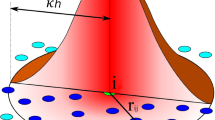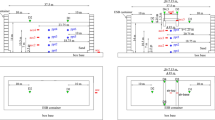Abstract
Deformation induced by liquefaction during an earthquake is one of the leading causes for damage to soils and foundations. Because of the significant reduction of the shear strength and shear modulus of post-liquefaction soils, lateral spread can develop from small deformation to the flow failure stage where the phase of the liquefied soils changes from solid to fluid. In this paper, two numerical methods are introduced: the finite element method (FEM) and the smoothed particle hydrodynamics (SPH) method. For the initial stage of small deformation of liquefaction, the FEM based on solid mechanics can accurately simulate the soil behavior. For the flow stage of liquefaction deformation, the SPH method in the framework of fluid dynamics is more suitable because the mechanical and deformation properties in the flow stage are similar to that of a viscous fluid. In this paper, recent advances in the field of liquefaction deformation analysis using the FEM and SPH methods are introduced, as a basis for future research.
Access provided by Autonomous University of Puebla. Download conference paper PDF
Similar content being viewed by others
Keywords
1 Introduction
When subjected to ground motion, the pore water pressure of soils increases sharply and the effective mean stress decreases accordingly until it reaches zero, leading to liquefaction. Significant reduction of shear strength and shear modulus of post-liquefaction soils can cause large lateral deformation and subsidence, which can result in serious damage to buildings and infrastructures on the surface. For example, in the 2010 and 2011 Christchurch (New Zealand) earthquakes, liquefaction caused up to 2–3 m of permanent lateral spread within 200–250 m of the city’s river (Cubrinovski et al. 2012). In the 1999 Kocaeli (Turkey) earthquake, lateral deformation induced by seismic liquefaction was found mainly along the shore and creeks with maximum displacement greater than 2 m (Kanıbir et al. 2006).
Early research into liquefaction paid more attention to the influencing factors and the likelihood of liquefaction occurring than to deformation prediction of post-liquefaction soils. The destruction induced by liquefaction deformation has highlighted the problem of post-liquefaction soil behavior and has recently attracted the attention of scholars. The finite element (FEM) method based on solid mechanics can accurately simulate the initial small deformation of liquefaction, whereas for the flow stage of liquefaction deformation, the smoothed particle hydrodynamics (SPH) method in the framework of fluid dynamics would be more suitable. This paper presents recent advancements in liquefaction deformation analysis using the FEM and SPH methods.
2 The Finite Element Method
FEM is a simple and useful tool for solving problems of continuous media. It has been applied widely in geotechnical engineering analysis, such as in the fields of deformation prediction, strength analysis, and stability estimation.
Huang et al. (2008a, 2009, 2012) have carried out many finite element simulations for small deformation of embankments on liquefiable soils. Because the liquefied soil is a saturated fluid–solid coupling medium, Biot’s dynamic coupled theory for saturated porous media simulation and a cyclic elastoplastic constitutive model were used. The liquefaction resistance and deformation characteristics of embankments under earthquakes were studied, and FEM was validated as a useful tool for seismic assessment and design of embankments.
The dynamic interaction of pile–soil–structure in a liquefiable site was also studied by FEM (Huang et al. 2005). A beam-column element, which takes into account the effect of volume and axial force, was selected to represent the dynamic behavior of piles. The vulnerable parts and the deformation laws of the whole system were calculated, providing a theoretical basis for the seismic design of piles in liquefiable sites.
The authors also proved the effectiveness of liquefaction mitigation measures that use the FEM method. A 2D-FEM program was used to verify the effect of reinforcement measures, revealing that the FEM method can provide useful results for seismic design of embankments (Huang et al. 2006). An effective stress based finite element-finite differences (FE-FD) method was used in the study of Huang et al. (2008b). The pore water pressure was calculated by the FD, while the displacement was obtained by the FE method. The simulation results illustrated that cement grouting cannot prevent soils from liquefying but it can substantially reduce the deformation induced by liquefaction.
3 The Smoothed Particle Hydrodynamics Method
The state of liquefied soils changes from solid to liquid phase with the full development of shear strain, and the mechanical and deformation properties become similar to those of a viscous fluid. Hence, the traditional method based on solid mechanics cannot simulate precisely the complex hydrodynamic behavior of post-liquefied soils. In recent years, new numerical methods in the framework of fluid dynamics have been proposed to overcome this limitation. In this paper, the SPH method for flow behavior of post-liquefaction soils is introduced.
SPH is a pure Lagrangian, meshless hydrodynamics method that has advanced rapidly in recent years and has been applied in many engineering fields. The continuous fluid is described by a serious of arbitrarily distributed particles in SPH, with each particle being assigned various physical quantities. Then, the mechanical properties of the whole system are obtained by calculating the kinetic equation of the particle group and tracking the movement of each particle. The most prominent advantage of this method is that it can successfully simulate free surfaces, flow deformation, and deformation boundaries (Liu and Liu 2003).
Huang et al. (2011, 2013) conducted extensive research on numerical simulation of large liquefaction-induced deformation using the SPH method. The authors used Bingham fluids and the Verlet neighbor list method to simulate the flow deformation and search neighboring particles, respectively (Huang et al. 2011). The method’s accurate simulation of the flow process of liquefied soils was validated by comparing with the test results. Huang et al. (2013) further proposed a soil–water-coupled SPH numerical modeling that treated soil and water as different layers. The application of this method was verified by test data and it was used to simulate the failure of an embankment on liquefied foundations.
4 Summary
Because historical cases have manifested the serious damage and destruction induced by liquefaction deformation, there is a need to establish effective numerical methods to simulate the whole process of liquefaction deformation. The FEM can be used to simulate the initial small deformation of liquefaction. For the subsequent flow deformation, the SPH method in the framework of fluid dynamics can produce a more accurate simulation compared to the traditional numerical methods based on soil mechanics, as it models the mechanism of liquefaction process on a grain scale level. Both FEM and SPH are important tools for seismic liquefaction assessment and 3D simulation should be conducted in further study.
References
Cubrinovski M, Robinson K, Taylor M, Hughes M, Orense R (2012) Lateral spreading and its impacts in urban areas in the 2010–2011 Christchurch earthquakes. NZ J Geol Geophys 55(3):255–269
Huang Y, Yashima A, Zhang F (2005) Finite element analysis of pile-soil-structure dynamic interaction in liquefiable site. Chin J Geotech Eng 27(6):646–651 (in Chinese)
Huang Y, Sawada K, Moriguchi M, Yashima A, Zhang F (2006) Numerical assessment of the effect of reinforcement on the performance of reinforced soil dikes. Geotext Geomembr 24(3):169–174
Huang Y, Yashima A, Sawada K, Zhang F (2008a) Numerical assessment of the seismic response of an earth embankment on liquefiable soils. Bull Eng Geol Environ 67(1):31–39
Huang Y, Zhang F, Yashima A, Ye WM (2008b) Numerical simulation of mitigation for liquefaction-induced soil deformation in a sandy ground improved by cement grouting. Environ Geol 55(6):1247–1252
Huang Y, Yashima A, Sawada K, Zhang F (2009) A case study of seismic response of earth embankment foundation on liquefiable soils. J Cent S Univ Technol 16(6):994–1000
Huang Y, Zhang WJ, Mao WW, Jin C (2011) Flow analysis of liquefied soils based on smoothed particle hydrodynamics. Nat Hazards 59(3):1547–1560
Huang Y, Zheng H, Zhuang ZJ (2012) Seismic liquefaction analysis of a reservoir dam foundation in the South-North Water Diversion Project in China. Part II: seismic response simulation. Nat Hazards 60(3):1313–1324
Huang Y, Zhang WJ, Dai ZL, Xu Q (2013) Numerical simulation of flow processes in liquefied soils using a soil–water-coupled smoothed particle hydrodynamics method. Nat Hazards 69(1):809–827
Kanıbir A, Ulusay R, Aydan Ö (2006) Assessment of liquefaction and lateral spreading on the shore of Lake Sapanca during the Kocaeli (Turkey) earthquake. Eng Geol 83(4):307–331
Liu GR, Liu MB (2003) Smoothed particle hydrodynamics: a mesh-free particle method. World Scientific Press, Singapore
Acknowledgments
This work was supported by the National Basic Research Program of China (973 Program, Grant No. 2012CB719803), the National Natural Science Foundation of China (Grant Nos. 41372355, 41225011) and the Chang Jiang Scholars Program of China.
Author information
Authors and Affiliations
Corresponding author
Editor information
Editors and Affiliations
Rights and permissions
Copyright information
© 2014 Springer International Publishing Switzerland
About this paper
Cite this paper
Yu, M., Huang, Y., Xu, Q. (2014). Numerical Methods for Deformation Analysis of Liquefiable Soils. In: Lollino, G., Manconi, A., Locat, J., Huang, Y., Canals Artigas, M. (eds) Engineering Geology for Society and Territory – Volume 4. Springer, Cham. https://doi.org/10.1007/978-3-319-08660-6_11
Download citation
DOI: https://doi.org/10.1007/978-3-319-08660-6_11
Publisher Name: Springer, Cham
Print ISBN: 978-3-319-08659-0
Online ISBN: 978-3-319-08660-6
eBook Packages: Earth and Environmental ScienceEarth and Environmental Science (R0)




